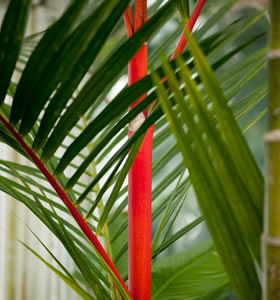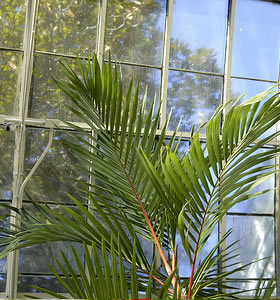A Festive Holiday Palm
Posted in Gardening Tips on December 24 2013, by Sonia Uyterhoeven
 During the holiday season, to put me in a festive mood, I rely on amaryllis, or wreaths decorated with berried juniper, variegated ivy, and incense cedar. But the other day, while I was walking through the Enid A. Haupt Conservatory for a glimpse at the Holiday Train Show, I found a plant in the aquatic plants gallery that already looks like it is decked out for Christmas.
During the holiday season, to put me in a festive mood, I rely on amaryllis, or wreaths decorated with berried juniper, variegated ivy, and incense cedar. But the other day, while I was walking through the Enid A. Haupt Conservatory for a glimpse at the Holiday Train Show, I found a plant in the aquatic plants gallery that already looks like it is decked out for Christmas.
The sealing wax palm, Cyrtostachys renda, is frightfully festive, decked out in jewel tones of red and green! Indigenous to Malaysia and Sumatra, this palm grows in swampy habitats. It is a slow growing palm that reaches about 30 feet tall in nature, but only to about 10 to 15 feet under glass.
It is an understory tree, which means that it prefers dappled light, but it can handle full sun. It spread by rhizomes to slowly spread and form attractive clumps. The sealing wax palm is grown, and known, for its stunning, bright red leaf sheaths and crownshafts. The trunk of the palm has a more subtle beauty, morphing from green to grey as it matures.

But, please do not think that I am encouraging you to grow this beautiful palm at home. I looked online for nursery prices, and I can only tell you that they are well past my price point! The high prices are due to the fact that the seeds are slow to germinate (sometimes up to one year) and can be tricky to propagate.
 The sealing wax palm is also challenging to grow. It likes high humidity, constant temperatures in the mid-seventies to -eighties, will not tolerate temperature drops below the forties, and enjoys wet feet. All in all, it is a specimen that I would suggest you come admire in our Conservatory, but not try to grow at home (unless you live in a tropical climate).
The sealing wax palm is also challenging to grow. It likes high humidity, constant temperatures in the mid-seventies to -eighties, will not tolerate temperature drops below the forties, and enjoys wet feet. All in all, it is a specimen that I would suggest you come admire in our Conservatory, but not try to grow at home (unless you live in a tropical climate).
This palm is also commonly known as the lipstick palm. While the latter appellation is self-explanatory–the red of the leaf sheaths really are as bright red as a tube of “Love That Red”–its other name is a bit more cryptic, coming from an historical association. Once upon a time, the nobility of many countries would use red sealing wax to seal their letters. The wax was traditionally made from beeswax and resin, and colored vermillion by the mineral cinnabar. Lipstick was traditionally also made from beeswax and oils, with coloring added, but now I digress.
When you visit the NYBG for the Holiday Train Show, which runs through January 12, I recommend that you spend a few moments wandering around the Conservatory and admiring some of our botanical treasures. The sealing wax palm is located in the corner of the same gallery as the incredible Red Jade Vine. Happy holidays!

